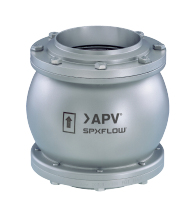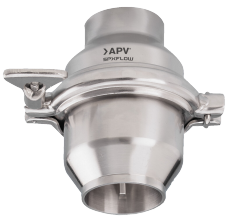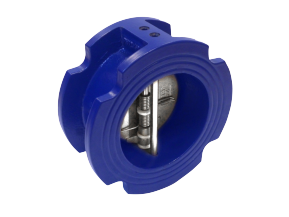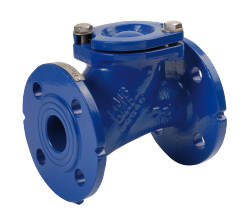Check valves enable fluid flow in one direction while preventing backflow, featuring various designs. They operate automatically and find wide applications across industries for maintaining system integrity and efficiency.



Check Valves
6 series from 3 manufacturers
-
- Agriculture
- Bakery and confectionery
- Beauty & Personal Care
- Brewing and beverages
- Building Services
- Chemical
- Convenience food
- Dairy
- Detergents
- Distilleries
- Food & Beverage
- Fruit Concentrates
- Oil Fats & Mayonnaise
- Pet Food
- Petrochemical
- Pharmaceutical
- Research & Development
- Transportation
- Water Treatment
-
- Analysis
- Circulation
- Cleaning
- Control
- Conveying
- Cooling
- Descaling
- Desinfection
- Dewatering
- Diagnostic
- Discharge
- Distribution
- Dosing
- Drain
- Drainage
- Dredging
- Dual Dispensing
- Extraction
- Feed
- Filling
- Filtration
- Flow Control
- Greasing
- Grinding
- Handling
- Heating
- High-Pressure
- High-Temperature
- High-Volume
- Injection
- Irrigation
- Level Control
- Lift
- Lifting
- Loading
- Low-Pressure
- Lubrication
- Medium-Pressure
- Off-loading
- Powder Coating
- Pressurisation
- Process
- Processing
- Recirculation
- Recovery
- Refueling
- Replacement
- Rinsing
- Sampling
- Settling
- Spraying
- Tempering
- Transfer
- Treatment
- Unloading
- Volumetric Dispensing
- Washing
- Water-Jet Cleaning
-
- Alcohols
- Beer
- Biological Broths and Slurries
- Caustic Solutions
- CIP Fluids
- Dairy Products
- Drinking Water
- Emulsions
- Fruit and Vegetables
- Fruit Concentrates
- Low Viscosity Liquids
- Milk
- Must
- Personal Care Products
- Pet Food
- Sauces
- Sewage
- Soaps and Detergents
- Solvents
- Spirits
- Thin Liquids
- Vegetable Oils
- Vinegar
- Wastewater
- Water
- Wine
- Wort
The Operating principle of Check Valves
Check valves operate on a simple principle: they allow fluid to flow in one direction while preventing backflow. This is achieved through a mechanism typically consisting of a movable flap, disc, or ball that opens when fluid flows in the desired direction, allowing it to pass through the valve. When the flow stops or reverses, the flap, disc, or ball is forced against a seat by the pressure of the fluid, effectively blocking the flow in the opposite direction. This ensures that fluid can only move in the intended direction, preventing backflow and maintaining system efficiency and safety.

Types of Check Valves
There are several types of check valves, each designed for specific applications and operating conditions. Common types include:
- Swing Check Valve: This type of check valve has a hinged disc that swings open to allow forward flow and swings closed to prevent backflow.
- Lift Check Valve: In lift check valves, the disc moves vertically (lifts) to allow forward flow and drops to seal the valve and prevent backflow.
- Ball Check Valve: Ball check valves use a ball-shaped disc that moves within the valve body to control flow. When forward flow occurs, the ball is pushed away from the seat, allowing fluid passage. When backflow happens, the ball returns to the seat, preventing reverse flow.
- Diaphragm Check Valve: Diaphragm check valves use a flexible diaphragm to regulate flow. When forward flow occurs, the diaphragm flexes to allow fluid passage. During backflow, the diaphragm returns to its original position, sealing the valve.
Advantages & Disadvantages of Check Valves
Check valves offer several advantages in fluid handling systems, but they also come with certain limitations.
Advantages
Check valves offer several advantages in fluid handling systems.
Firstly, they prevent backflow, ensuring that fluid flows in one direction only, thus maintaining system efficiency. Additionally, their simple design makes them easy to install and operate, reducing maintenance requirements. Moreover, check valves typically have minimal resistance to flow, resulting in a lower pressure drop across the valve. They also offer versatility, as they are available in various designs, sizes, and materials to suit different applications and operating conditions. Lastly, their cost-effectiveness makes them a preferred solution for many fluid handling systems.
Disadvantages
Check valves come with certain limitations that need to be considered.
Firstly, they offer limited control, primarily designed for on/off operation, which may not provide precise control over fluid flow rates. This can be problematic in applications requiring precise flow regulation. Secondly, there's the potential for leakage, especially in high-pressure or high-temperature applications, which can compromise system integrity and efficiency. Additionally, rapid closure of check valves can generate water hammers, leading to pressure surges that may damage piping and equipment. Some designs also pose flow restrictions, increasing energy consumption or reducing system performance. Lastly, while check valves have simple designs, they still require periodic inspection and maintenance to ensure proper operation and prevent issues such as fouling or corrosion, which can lead to valve failure and costly downtime.
Important Consideration when Selecting a Check Valve
When selecting a check valve, several important considerations should be taken into account to ensure optimal performance and compatibility with the application:
- Flow Direction: Check valves are designed to allow flow in one direction only. It's crucial to determine the direction of flow in the system and select a check valve that is suitable for that direction.
- Type of Check Valve: Check valves come in various types, including swing check valves, lift check valves, and tilting disc check valves. Each type has its own advantages and limitations, so the specific requirements of the application should guide the selection.
- Pressure Rating: Check valves have pressure ratings that define the maximum pressure they can withstand. It's essential to choose a check valve with a pressure rating that matches or exceeds the maximum operating pressure of the system to ensure safety and reliability.
- Flow Rate: Consider the flow rate of the system to ensure that the selected check valve can handle the expected flow without causing excessive pressure drop or flow restriction.
- Size and Connection Type: Check valves come in various sizes and connection types, including threaded, flanged, and socket weld. Select a check valve with the appropriate size and connection type to fit seamlessly into the existing piping system.
- Material Compatibility: Check valves are available in different materials, such as stainless steel, brass, and PVC, to suit various fluid types and operating conditions. Choose a material that is compatible with the fluid being handled and resistant to corrosion, erosion, and chemical degradation.
- Operating Conditions: Consider the temperature, pressure, and environmental conditions in which the check valve will operate. Ensure that the selected valve is capable of withstanding the expected operating conditions to prevent premature failure or malfunction.
Why Buy Check Valves from AxFlow
At AxFlow, we recognize the pivotal role check valves play in ensuring seamless fluid flow within your systems. Backed by our team of seasoned professionals, we're committed to delivering tailored solutions that meet your unique demands, drawing upon extensive industry knowledge. Our comprehensive selection includes a variety of check valves sourced from top global manufacturers, guaranteeing access to cutting-edge technology. Whether you require assistance with selection, installation, or maintenance, our dedicated experts are poised to offer unwavering support at every stage. Rely on AxFlow for dependable performance and unmatched assistance with all your check valve needs.








